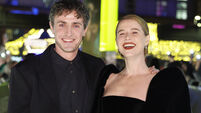Book Extract: Multiple Joyce: 100 Short Essays about James Joyce's Cultural Legacy
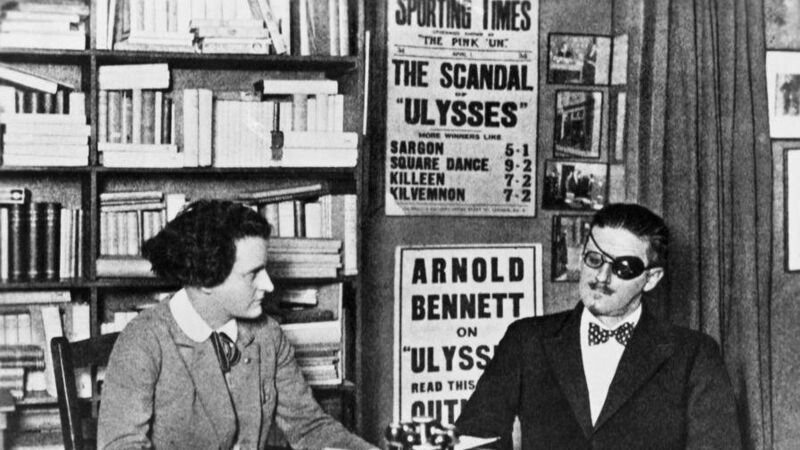
Joyce and his publisher Sylvia Beach sitting together in her office at Shakespeare and Company (12, rue de l’Odéon, Paris)
Here’s a well-known photograph of Joyce and his publisher Sylvia Beach sitting together in her office at Shakespeare and Company (12, rue de l’Odéon, Paris) and, behind them, two newspaper placards, no doubt obtained locally, and perhaps surreptitiously.
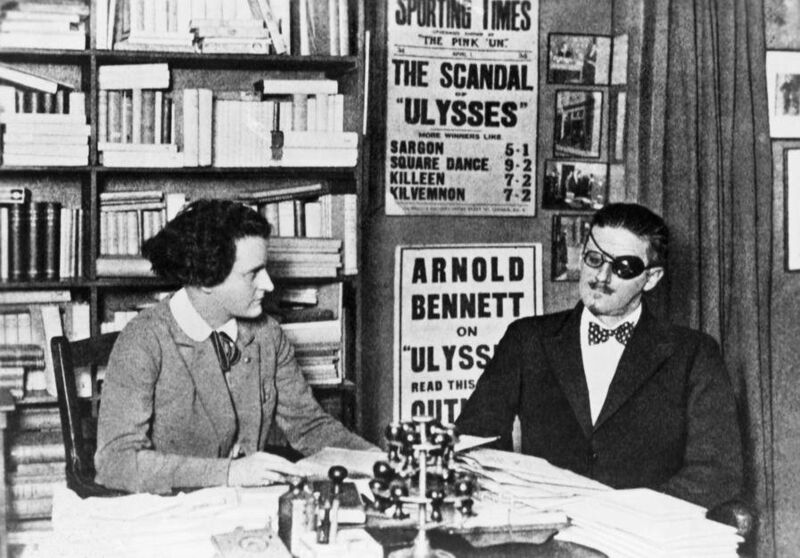
The top one, advertising Sporting Life (known colloquially as ‘The Pink ’Un’) screams THE SCANDAL OF “ULYSSES”, below which are some horse racing odds:
SARGON (5–1)
SQUARE DANCE (9–2)
KILLEEN (7–2)
KILVEMNON (7–2).
According to the Pall Mall Gazette (27th March 1922), Sargon and Kilvemnon had both won their respective races at Warwick, and Sporting Life had tipped them both, which explains the placard. ‘The Pink ‘Un’s’ literary critic was an anonymous hack named ‘Aramis’, whose view was that [Ulysses] "appears to have been written by a perverted lunatic who has made a speciality of the literature of the latrine . . . I have no stomach for Ulysses. [. . .] James Joyce is a writer of talent, but in Ulysses he has ruled out all the elementary decencies of life and dwells appreciatively on things that sniggering louts of schoolboys guffaw about. In addition to this stupid glorification of mere filth, the book suffers from being written in the manner of a demented George Meredith. There are whole chapters of it without any punctuation or other guide to what the writer is really getting at. Two-thirds of it is incoherent, and the passages that are plainly written are devoid of wit, displaying only a coarse salacrity [sic] intended for humour."
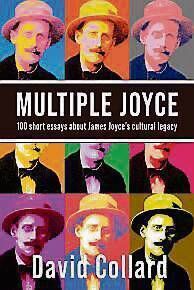
Later in the review ‘Aramis’ says, puce-faced, that Ulysses would ‘make a Hottentot sick’.
There’s a second placard in the photograph announcing the author Arnold Bennett’s review of the novel, which appeared in The Bookman (August 1922). ‘I see nothing very wonderful in this’ he harrumphed.
Has there ever been an anthology of authors writing about Ulysses? By which I mean a collection of writings for and against by other novelists, contemporaries of Joyce with skin in the game, whether in reviews or essays or letters or diary entries? And has there ever been a collection of the countless negative reviews of the greatest novel ever written? That could be interesting, and form the basis for a chapter in my long-planned Short History of Philistinism.
My take on the subject—hardly original—is that throughout the 19th and 20th centuries, and in our time, any innovation in the arts, from The Rite of Spring to Anarchy in the UK, from the Fauves to the Entartete Kunst, from Alfred Jarry’s Ubu Roi to Beckett’s En attendant Godot, from Duchamp’s ‘Fountain’ to Carl Andre’s ‘Equivalent VIII’, has been met with precisely the same incomprehension, hostility, derision and mockery, with the artists invariably depicted as cynical conmen trying to pull a fast one on the public in order to make a dishonest living.
If I can persuade a publisher to back the project I’d start my researches at the James Joyce Collection in the University of Buffalo, the source of the photograph that prompted this essay. Looking at the website page that summarises the unrivalled contents of the collection and then at the magnificent catalogue I found myself reflecting glumly on the lack of a paper trail left by most writers these days:
Covering the entire span of his artistic life, the James Joyce Collection is the largest Joyce collection in the world and contains his private library; holograph drafts, typescript pages and corrected galleys and page proofs for Ulysses; 66 notebooks, transcriptions, typescripts, galleys, page proofs and the author’s copy with corrections of Finnegans Wake; documents for A Portrait of the Artist as a Young Man and Joyce’s lecture on Daniel Defoe; the notebook for the author’s only play Exiles; hundreds of letters between Sylvia Beach and Joyce; Beach’s printing records for the publication of Ulysses; American collector John Quinn’s letters to Beach and Joyce regarding the trial over Ulysses and The Little Review as well as other Joyce and Beach correspondence; Joyce’s presentation copies to Beach; portraits and over 150 photographs of Joyce and his family; numerous personal artifacts [sic] owned by Joyce; thousands of his newspaper clippings; and notebooks, sketchbooks and letters by Joyce and Nora’s daughter Lucia. Supplementing the archive is a complete set of first editions, including all issues and states of every book published by Joyce, translations, a large number of his magazine appearances and virtually all the literary criticism in book form on Joyce.
The founding donation, known as The Wickser Gift after its donor, consisted of the contents of the Librairie La Hune’s Joyce exposition, held in Paris in 1949 to raise funds for the Joyce family. It included manuscripts, Patrick Tuohy’s portraits of Joyce and his father and other items of memorabilia. Perhaps the most extraordinary part of this gift was Joyce’s private library, which arrived in Buffalo in the same condition as it was when packed for storage after the Joyce family left Paris to flee the Nazi occupation. Further acquisitions came over the years from, among others, Marie Jolas and Sylvia Beach. It’s fully catalogued and available to inspect online.
But back to the Turf. A racehorse features in one of the few conventional plot points in Ulysses, one worthy of a modern-day situation comedy. Bloom bumps into a Dublin loafer named Bantam Lyons outside Sweny’s chemist shop and offers him his newspaper (‘—I say you can keep it, Mr Bloom answered. I was going to throw it away.’). Lyons mistakenly thinks this is a tip for a horse named Throwaway, an outsider running in that day’s Epsom Gold Cup. The tip is passed around Dublin and Lenehan [Matt Lenehan, a rowdy character in Ulysses] later claims that Bloom had himself placed a big wager on the nag at odds of five to one. The horse comes from behind to win (as happened in real life) and there follow some predictably anti-Semitic speculations about the Jews having a hand in everything.
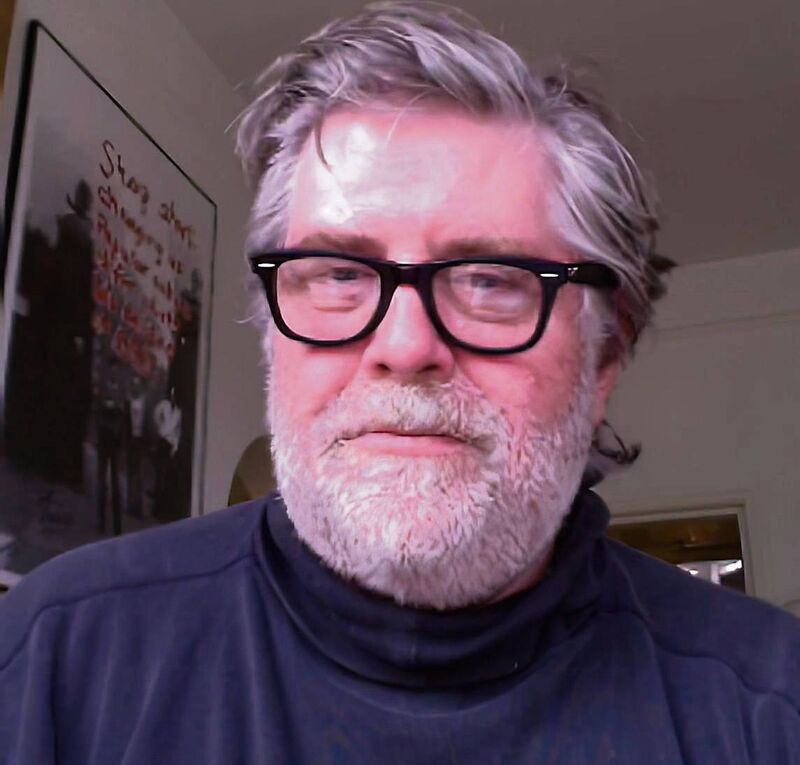
Still on the Turf, one of many revelations in Vivien Igoe’s book The Real People of Joyce’s Ulysses: A Biographical Guide (University College Dublin Press, 2016) is about the jockey Herbert ‘Morny’ Cannon, who appears in the novel. Here’s Bloom, musing about the Epsom Gold Cup: ‘Zinfandel’s the favourite, Lord Howard de Walden’s, won at Epsom. Morny Cannon is riding him[.]’
What I didn’t know is that Cannon was great-uncle of the legendary jockey Lester Piggott (b. 1935). Cannon rode his first winner at the age of 13 and was, like his great-nephew, a phenomenal jockey. It must run in the family.



